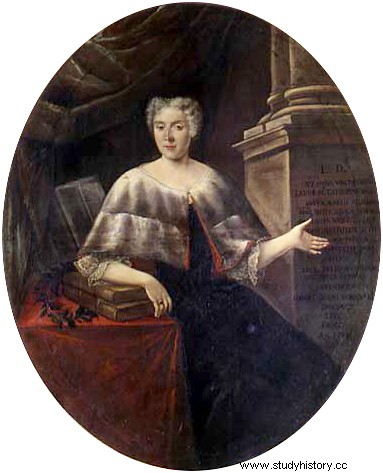Italian mathematician and physicist , Laura Maria Catarina Bassi (1711 – 1778) was one of the first women to obtain a university chair . It largely contributed to spreading Newtonian ideas in Italy.
A brilliant student

Laura Maria Catarina Bassi was born between October 29 and 31, 1711 in Bologna, Italy, into a prosperous family. Her father is a lawyer. From childhood, Laura learned French and Latin in particular, and distinguished herself by her keen intelligence. In view of the child's predisposition for studies, his father decided to entrust him to Gaetano Tacconi, who taught medicine at the University of Bologna, which was already seven centuries old.
Laura learned alongside him for seven years; they will end up moving away when the young woman shows her interest in Newton's theories. She also continued her learning in languages, natural history, geometry, philosophy and arithmetic with one of her cousins, Lorenzo Stegani. During her studies, she was noted for her intellectual acumen, not only by professors and students and the university, but also by Cardinal Prospero Lambertini, who would become pope in 1740 under the name of Benedict XIV, and who, keen on science, follows his progress with great interest.
PhD in Philosophy
In 1732, Laura Bassi defended her thesis and became a doctor of philosophy; she is also appointed reader in physics and mathematics, which she teaches along with anatomy. Although women were then in a very small minority at university, Italian universities – and particularly that of Bologna – were much more open than their French counterparts at the same time:in the 13th century, Bettisia Gozzadini, considered the first woman appointed professor in a university, thus teaches law there; Alessandra Giliani studied medicine there in the 14th century; Finally, from 1390, Dorotea Bucca occupied a chair of medicine and philosophy there for forty years.
Laura is not only admitted to the university, but she enjoys support and honors there. Its courses are renowned and attract students from all over Europe; she notably teaches the physicist Alessandro Volta. Beyond his teachings, his reputation crosses borders. The mathematician Emilie du Châtelet, Newton's translator, has great admiration for him, as does Voltaire, with whom she corresponds.
Laura married in 1738 Giuseppe Veratti, who taught physics and medicine at the University of Bologna. The sources do not agree on the number of children they will have, six, or twelve of which only five will reach adulthood, but her new family life does not prevent Laura from continuing her research or her teachings. /P>
Academic career
Always interested in Newtonian ideas, Laura Bassi teaches them, writes articles about them and largely contributes to their dissemination in Italy. She does not write books, but submits numerous texts and articles to the Bologna Academy of Sciences, in physics, mathematics, mechanics and chemistry.
In 1745, Pope Benedict XIV, who had a great interest in science as well as in Laura's work, created a group of twenty-five scholars, the Benedettini . Despite some reluctance, he gets Laura admitted, who will be the only woman to be part of it. After his death and following a period of vacancy, the chair will pass to another woman, Dr. Maria Dalle Donne. In 1772, Paolo Balbi, professor of experimental physics at the University of Bologna, died; Laura is named in her place and receives her chair of experimental physics, with her husband as her assistant.
Laura Bassi died in 1778 at the age of 66, after a rich and fruitful scientific career, both in the field of research and in that of teaching. Along with those that preceded her, she helps to legitimize the place of women in a university environment that is still very closed to them.
